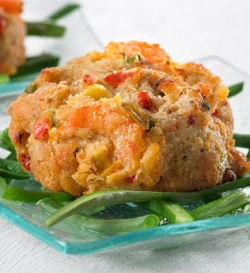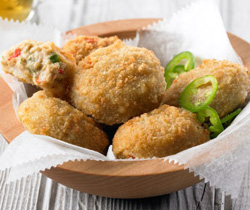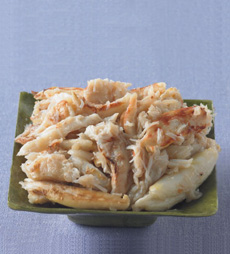|
|
 Color makes little difference in a crab cake, so there’s no need to pay more for expensive white lump meat. Photo of crab and shrimp cake on a bed of haricots vert (French green beans) courtesy PhillipsFoods.com. Recipe on website. |
- They are the best gauge of the size of the crab. Lumps smaller than one inch in diameter are typically taken from undersized, juvenile crabs. Harvesting of juveniles of any species, that have not yet had a chance to reproduce, can have disastrous effects on its population and does not indicate a responsible producer.
Now, have a taste and look for:
- Texture. Top-quality crab meat will have a firm texture with distinguishable muscle fiber—never mushy or mealy. The texture of the crab meat can vary according to a number of factors, including the freshness of the crabs when brought to the plant, and the method of processing. The best processors use a very short canning process and, if pasteurized, a small can (6 or 7 ounces), for minimal “cooking” effect. This best preserves the delicate flavor and texture of the fresh crab meat. “Institution size” cans of crab will not yield the best flavors, because they need to cook longer.
|
 While the color of the crab doesn’t matter in many recipes, the shell content does. Few people want to find crunchy shell fragments and cartilage in their crabmeat. If a brand is very inexpensive, you might find that it is less “picked.” So test a can before you make that important party recipe. Photo of Jalapeno Crab Slammers courtesy PhillipsFoods.com. Recipe on website. |
- Flavor. At the end of the day, it’s great crab flavor that is the hallmark of quality crab meat. The crab should taste fresh and clean, slightly salty (“of the sea”), with no unpleasant aftertaste. Some additives impart a chemical flavor or aftertaste to the crab meat. Cheaper cans can can contribute a tinny flavor (paper liners are used to try to mitigate this problem). Crab is lighter flavor in than other crustaceans; you should be able to enjoy its nuances.
Each bite of crab meat should be a delight. If it isn’t, you need to find a better brand.
Get The Book About Crab
 For more information about crab, including wonderful recipes, see Crab: Buying, Cooking, Cracking, by Andrea Froncillo and Jennifer Jeffrey. A complete guide to buying, cleaning, preparing and eating crab. The 35 recipes and tantalizing food photos make you want to race to the nearest fishmonger and load up on crab to cook through the book from the beginning to the end. Recipes range from casual to fancy, and any type of crab meat—Alaska snow, blue, Dungeness, etc.—can be substituted.
For more information about crab, including wonderful recipes, see Crab: Buying, Cooking, Cracking, by Andrea Froncillo and Jennifer Jeffrey. A complete guide to buying, cleaning, preparing and eating crab. The 35 recipes and tantalizing food photos make you want to race to the nearest fishmonger and load up on crab to cook through the book from the beginning to the end. Recipes range from casual to fancy, and any type of crab meat—Alaska snow, blue, Dungeness, etc.—can be substituted.
Return To The First Page Of This Article
Lifestyle Direct, Inc. All rights reserved. Images are the copyright of their respective owners.
![]()
© Copyright 2005-2026 Lifestyle Direct, Inc. All rights reserved. All images are copyrighted to their respective owners.


